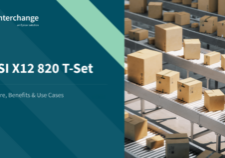Integrating EDI with your ERP
Enterprise resource planning (ERP) and electronic data interchange (EDI) have been an integral part of business processes since globalisation made hyper-connectivity essential for rapid communication across borders. Meanwhile, increasing computing power has made data more readily available, increasing access to high-quality business insights.
ERP looked to amalgamate multiple disparate processes into one. While ERP sought to centralise data, EDI implementations looked to facilitate data interchange between two or more parties, modernising logistics and supply chain management.
Today, both ERP and EDI continue to grow and develop. Almost all businesses will need to implement ERP software at some stage, and the EDI market is expected to expand from $1.88 billion in 2022 to $4.04 billion by 2029.1
Given that these business systems overlap in the realms of procurement and supply chain management, there has been much discussion around integrating ERP systems with EDI. However, despite the fact that integrations have been in place for several decades, adoption has been slow.
Today we’re going to look at ERP and EDI integration in more detail. Let’s get started.
What is Electronic Data Interchange?
critical information that was traditionally communicated on paper documents. This includes:
- Delivery forecasts
- Purchase orders
- Delivery notes
- Invoices
EDI first emerged in the 1960s, but it wasn’t until later that many businesses and organisations across the world added EDI to their repertoire. Decades later, EDI solutions have been transformed with developments such as
The benefits of EDI
Developed to facilitate business-to-business communications that eliminate paper-based documents and human error, EDI solutions have developed over time. Modern solutions are now utilising cloud computing, API integrations and value-added networks (VANs) — providing access to cutting-edge tools and speeding up both deployment and onboarding.
The capabilities that come with the deployment of these modern solutions can provide businesses with a wide range of benefits, including:
- Increased speed: EDI streamlines communications throughout supply chains. Transferring business documents and data electronically is far superior to manual processing, increasing business cycle speed by 61%.2
- Cost savings: Increased business cycle speed ensures better outcomes across the entire supply chain, from procurement and supply to last-mile delivery. EDI cuts transportation and storage costs, reducing reliance on warehouse space and facilitating just-in-time (JIT) logistics.
- Improved accuracy and reduced errors: EDI enables accurate computer-to-computer data exchange. Automated electronic exchange reduces reliance on paper document exchange and manual data entry, improving accuracy and reducing errors.
- Higher levels of efficiency: Modern EDI uses automation to optimise processes. This enables businesses to reduce labour hours spent on long-winded manual processing and redirect efforts to drive efficiency. Increased document accuracy and efficiency ranked as the first and second most important benefits in a study of modern EDI.3
- Connectivity: Modern EDIs integrate with other enterprise tools and platforms, such as ERPs. EDI data is no longer siloed in a single specialist department — it can be piped to other applications to enrich business insights and analysis.
What is an ERP?
Enterprise resource planning (ERP) software started rolling out to the mainstream market around the same time as EDI. Fundamentally, ERP seeks to combine and centralise multiple business tasks and processes, including:
- Accounting
- Procurement
- Project management
- Risk management
- Compliance
The modern ERP software market is colossal — it was worth an estimated $43.72 billion in 2020 and is forecast to grow to around $100.7 billion by 2025. While ERP software is
dominated by SAP, Oracle, Sage, Epicor and Intuit, numerous other industry-specific options also exist.
Interestingly, ERP software has followed a similar path to EDI, moving from on-site legacy installations to cloud integration.
The benefits of ERP
ERP integrates once-siloed business processes into one overarching ERP platform. The result is the facilitation of rapid data sharing between the various departments within an organisation, increasing a business’s visibility of its data.
Moreover, ERPs include numerous data integrity features to ensure data accuracy when ingesting data from multiple sources, including automatic data validation, cleaning and deduplication. The end goal is to create a single centralised source of truth that details all enterprise resources.
Ultimately, utilising an ERP can provide businesses with:
- Enhanced reporting
- Costs savings
- Process improvements
- Effective supply chain management
What is EDI and ERP integration?
Data connectivity and integration are essential in today’s agile and fast-moving world. EDI and ERP are both fundamentally data-centric applications, and fostering cross-communication between the two ensures data is mobilised and not siloed.
To create the elusive single source of truth for all their data, businesses must seek to integrate data from EDI platforms into their ERP. Given that some 88% of businesses using EDI also use ERP, integration is common sense to bridge two business-critical platforms.
The issue is that ERP is more generalised and overarching, whereas EDI is oriented towards supply chains and logistics specifically. In addition, EDI standards such as EDIFACT, TRADACOMS and PEPPOL use their own unique structure and syntax, which is not readily known to ERP software.
However, EDI data is clearly valuable for an ERP and vice-versa — it’s just a matter of integrating the EDI front-end to the ERP back-end. That way, the systems can talk to each other to exchange internal and external data and create automated workflows.
Why should you integrate EDI and your ERP system?
EDI and ERP integrations make it possible to automate processes between EDI solutions and ERP systems. This works to optimise the transfer of business-critical information and accelerate business cycles.
For example, if a customer’s stock is running low an outbound EDI 850 purchase order (PO) is generated and sent to their supplier. Without integrating EDI and ERP, the PO would have to be manually raised with the supplier. However, integration with the supplier’s ERP can automate the process of stock replenishment without human intervention, as the PO is triggered by ERP data indicating that current stock is low.
In simple terms, integrating EDI with an ERP helps to facilitate automation and analysis, create internal efficiencies and reduce the chances of human error impacting business-critical documents.
The benefits of integrated EDI
EDI-to-ERP integration creates a pipeline between internal and partner-facing supply chain processes. Connecting the two is essential for modernising supply chains, creating a stronger value proposition for partners while strengthening internal business processes.
There are considerable benefits of EDI integration, but perhaps the most significant for businesses include:
- Integrating front-end EDI and back-end ERP: EDI provides front-end connectivity between trading partners, whereas ERP enables single-source record-keeping and analysis. Combining the two improves efficiency and reduces errors by automating the processing of business documents.
- Reduced costs: EDI integration with ERP allows businesses to minimise costs and remain competitive by reducing and even eliminating human errors and their associated business costs.
- Process optimisation: Automated pipelines between EDI and ERP optimise processes and accelerate business cycles. Businesses can integrate supply-chain-related data like available stock, sales projections and warehouse storage capacity with EDI to facilitate responsive supply chain processes. Such automation is essential for just-in-time (JIT) supply chain management.
- Improved visibility: Building a single source of truth for ERP and EDI data improves overall supply chain visibility. Integration enables businesses to analyse their EDI data alongside other enterprise data, taking full advantage of their ERP’s data analysis and visualisation tools.
In light of these benefits, businesses should seek to connect their EDI and ERP systems to improve the functionality of both. While integration was once a difficult task, integration gateways with mapping functions, managed file transfers (MFTs) and enterprise-grade security are enabling frictionless communication between EDI and ERPs.
Secure integration solutions from Data Interchange
EDI and ERP integrations require flexibility and security to facilitate rapid data sharing and document translation between different formats and standards. Only then can businesses begin to automate document processing to eliminate human errors and enhance efficiency.
At Data Interchange, our Value Added Network DiNet can help you do just that. DiNet’s extensive protocol and data format translation support allows you to manage a single connection with access to over 10,000 business partners. You can also benefit from full visibility over data exchanges with a built-in audit trail functionality, sophisticated analytics and reporting capabilities.
On top of comprehensive support for popular ERP systems that facilitates the ability to send and receive data from ERP’s automatically, DiNet offers:
- Consistent service availability: Service reliability that exceeds 99.95% ensures you can transmit EDI messages with minimal disruption
- Comprehensive security: Data encryption and ISO 27001 certification means you and your partners can be confident your critical documentation is always secure.
- Access to cutting-edge tools: Access visibility over the data that matters to you with dashboards equipped with filtering, altering and reporting capabilities.
If you’d like to learn more about how we can support your EDI ERP integration needs, get in touch with our team today.






























































































































